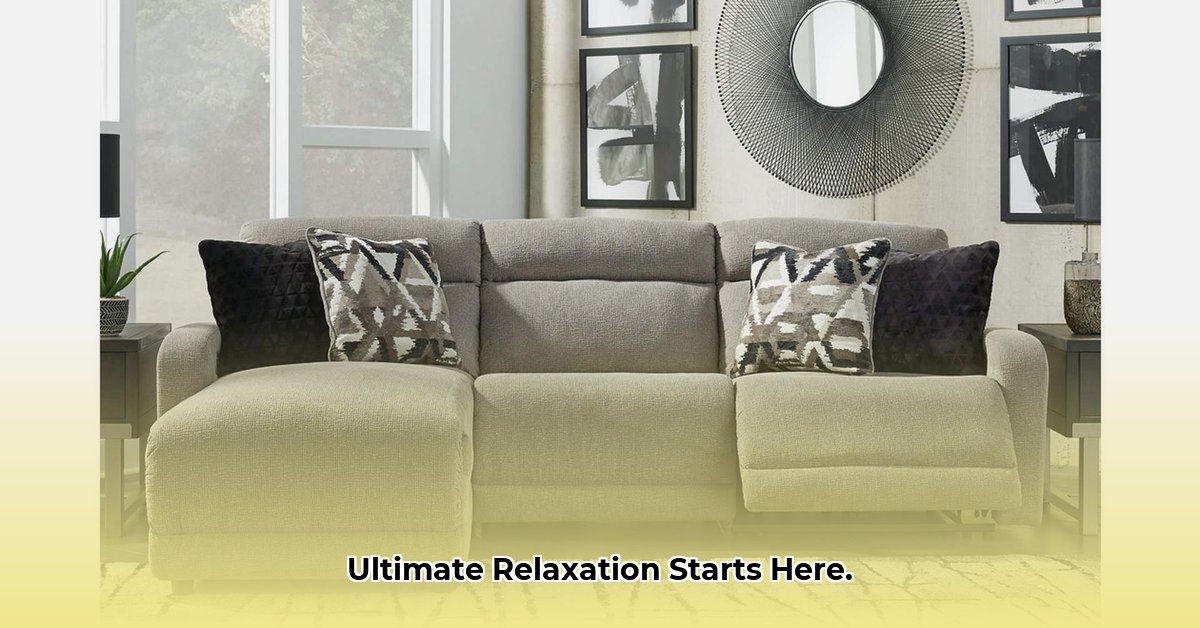Ever wish you could just melt into your couch after a long day? We get it. That feeling of sinking into pure comfort is amazing. This article is your ultimate guide to finding the perfect reclining couch with a chaise lounge – the kind that makes you want to stay in all day long. We’ll walk you through everything you need to know, from figuring out what size works best for your space to understanding the different materials and features. Think of this as your cheat sheet to buying a seriously comfy couch, one that’ll be a total game-changer in your living room. For even more options, check out these [reclining couches](https://www.wavesold.com/reclining-couch-sofa/). Let’s dive in and find your blissful relaxation spot!
Finding Your Ideal Relaxation: Reclining Couch with Chaise Selection
Ah, the end of a long day. You picture yourself sinking into something incredibly comfy, right? That’s where a reclining couch with chaise lounge comes in. It’s the ultimate relaxation station, but with so many options out there, finding the perfect one can feel overwhelming. Let’s navigate this together and make sure you find the couch of your dreams.
Sizing Up Your Space: Finding the Right Size and Measurements
Before diving into luxurious fabrics and power-reclining mechanisms, let’s talk reality: space. Grab your measuring tape! Seriously. Measure the area where your new couch will live, remembering to factor in walking space—you don’t want to feel like you’re navigating an obstacle course in your own living room. A couch that’s too big will swallow your room whole, while one too small will feel cramped.
Here’s what to keep in mind to maximize your living space:
- Overall Dimensions: Online retailers usually provide detailed dimensions. Double-check these before you buy! There’s nothing worse than a surprise when your new furniture arrives. Pay close attention to the depth and height, as these can dramatically affect how the couch fits in your room.
- Chaise Length: Think of the chaise as an extension of your couch. Its length significantly adds to the overall footprint, especially in smaller living spaces. Consider whether the chaise is reversible or fixed on one side, influencing your room layout options.
- Sectional Configuration: Corner sectionals come in many configurations. Consider the space you have available against your walls and how people move around your room. L-shaped or U-shaped? Modular or fixed? Each design choice impacts space usage.
Upholstery Options: Balancing Durability and Style
The upholstery is where you get to choose both the look and feel of your new relaxation haven. Leather is a classic choice, known for its durability and a sophisticated look. It’s also usually more expensive and can feel a bit stiff—not exactly cozy-blanket territory. On the other hand, fabric options are incredibly diverse in color and texture. They’re usually softer and cozier, but you’ll likely need to clean them more often.
Let’s weigh the pros and cons providing a balanced perspective:
| Upholstery Type | Pros | Cons |
|---|---|---|
| Leather | Durable, easy to clean (especially spills), elegant appearance, can last for years with proper care, develops a unique patina over time. | Expensive, can be less comfortable in extreme temperatures (hot or cold), prone to scratches, requires occasional conditioning. |
| Fabric | Wide variety of colors and textures, comfy feel, can be more budget-friendly, performance fabrics offer enhanced stain resistance and durability benefits. | May require more frequent cleaning, potentially less durable than leather (though performance fabrics are closing the gap), can stain more easily, some fabrics fade in sunlight. |
Beyond leather and standard fabrics, consider these upholstery options:
- Faux Leather (PU Leather): Offers a leather-like look at a lower cost, easy to clean, but less durable than genuine leather.
- Microfiber: Soft, durable, and stain-resistant, making it a good choice for families with children or pets.
- Velvet: Luxurious and soft, but can be more prone to staining and wear.
- Linen: Breathable and natural, but wrinkles easily and may not be the best choice for high-traffic areas.
Reclining Mechanisms: Manual vs. Power Reclining
Now, the fun part: reclining! Manual recliners are the traditional route—you’ll need to use your hands to adjust the backrest and footrest. Power recliners, however, use buttons or levers. Picture this: a long day, and all you have to do is press a button to sink into ultimate comfort.
So, manual or power? Manual offers a more classic feel and can be slightly more budget-friendly. Power recliners are exceptionally convenient, especially if you have mobility concerns or simply appreciate effortless relaxation. It depends entirely on your preferences and budget. Consider which type aligns better with your daily usage and long-term needs.
Here’s a detailed comparison:
| Feature | Manual Reclining | Power Reclining |
|---|---|---|
| Operation | Lever or handle to activate the reclining mechanism. | Buttons or remote control to adjust the reclining position. |
| Comfort | Requires physical effort, can be less precise in adjusting the angle. | Effortless adjustment, allows for precise positioning, often includes features like lumbar support and adjustable headrests. |
| Accessibility | May be challenging for individuals with limited mobility or strength. | Easier to use for individuals with mobility issues. |
| Cost | Generally less expensive than power recliners. | Generally more expensive due to the added motor and electrical components. |
| Maintenance | Fewer components mean less potential for mechanical issues. | Requires a power outlet, and the motor or electrical components may need occasional maintenance or repair. |
| Space | May require slightly more space behind the couch to fully recline. | Some models offer wall-hugging designs that require minimal space behind the couch. |
| Added Features | Typically simpler in design with fewer extra features. | Often includes features like USB charging ports, built-in lighting, and memory settings to save your favorite reclining positions. |
Extra Comfort: Adjustable Headrests and Built-in Lighting
Many reclining couches with chaise lounges come with extra features that enhance the experience. These are definitely nice-to-haves, but not absolute necessities:
- Adjustable Headrests: Customize your support for optimal comfort, especially important for taller individuals. Some headrests adjust manually, while others are powered.
- Cupholders: Perfect for keeping your drink within reach, and those pesky remotes. Look for cupholders with removable inserts for easy cleaning.
- Storage: Some models include hidden storage compartments—a great way to keep clutter out of sight. Ottomans with storage or compartments built into the armrests are popular options.
- Built-in Lighting: Ambient lighting can create a truly relaxing atmosphere. Look for LED lighting with adjustable brightness settings.
- USB Charging Ports: Convenient for charging your devices while you relax.
- Massage and Heat: Some high-end models offer massage and heat functions for the ultimate relaxation experience.
Achieving Ultimate Relaxation: Prioritizing Comfort and Budget
Finding your perfect reclining couch with chaise depends on your lifestyle and budget. Prioritize comfort and what features are most important to you. Think about how you’ll use the couch most often. Remember that this is a long-term investment; choose wisely! Happy relaxing!
Reclining Sectional in Small Spaces: How to Choose the Right Size
Cramped apartment? Yearning for ultimate relaxation? Don’t despair! You can absolutely have both. The key is finding the perfect reclining sectional that fits your space without sacrificing comfort. Let’s navigate the process together.
Space Evaluation: Measuring Your Space
Before you even start browsing online, grab a measuring tape. Seriously. This is the most crucial step in how to choose the right size reclining sectional for my small apartment. Measure not only the available floor space but also doorways, hallways, and any turns your sectional will need to traverse. A sectional that’s perfect on paper could become a monumental moving challenge. Consider these measurements to create a functional and inviting space:
- Available Floor Space: Account for walkways, furniture placement, and the swing of doors. Consider how the sectional will impact the flow of traffic in your apartment.
- Doorway Width & Height: Ensure easy passage. Measure the narrowest point of each doorway.
- Hallway Width & Turns: This is crucial for delivery and future rearranging. Pay special attention to tight corners or narrow passages. Remember to measure diagonally if needed.
- Ceiling Height: Especially relevant if you are considering a high-backed sectional or one with tall headrests.
Think of your apartment layout like putting together a complex jigsaw puzzle – every piece matters. What styles are best for small spaces?
Optimal Styles: Sectional Styles
Different sectional styles cater to different needs and spaces. Consider these options:
- Modular Sectionals: These are lifesavers for small apartments. Modular designs are flexible, allowing you to arrange and rearrange pieces to perfectly fit your space, even
- Glass Tile Shower Ideas to Create a Stunning Bathroom Space - December 7, 2025
- Glass Wall Tile Ideas for Kitchens and Bathrooms - December 6, 2025
- Glass Tile Bathroom: Create a Beautiful, Easy-Clean Space - December 5, 2025










